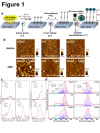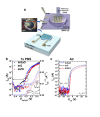Control of sensitivity in metal oxide electrolyte gated field-effect transistor-based glucose sensor by electronegativity modulation
- PMID: 39516503
- PMCID: PMC11549364
- DOI: 10.1038/s41598-024-76885-x
Control of sensitivity in metal oxide electrolyte gated field-effect transistor-based glucose sensor by electronegativity modulation
Abstract
In this study, the sensitivity of electrolyte-gated field-effect transistor-based glucose sensors using oxide semiconductor materials was controlled via electronegativity modulation. By controlling the enzymatic reaction between glucose and glucose oxidase, which is affected by the surface potential, the sensitivity of the glucose sensor can be effectively adjusted. To evaluate the sensitivity characteristics of the glucose sensor according to electronegativity control, devices were fabricated based on InO through Ga and Zn doping. The results confirmed that the specific sensitivity range could be adjusted by increasing the electronegativity. In addition, density functional theory calculations, confirmed that the attachment energy of the surface-functionalized material and the enzyme binding energy in the surface-functionalized thin film can be modulated depending on the electronegativity difference. The dissociation constant was controlled in both directions by doping with metal cations with larger(Ga, 1.81) or smaller(Zn, 1.65) electronegativities in InO(In, 1.78). We expect that this study will provide a simple method for the gradual and bidirectional control of the glucose sensitivity region.
Keywords: Density functional theory (DFT); Electronegativity; Glucose sensor; InGaO; InO; InZnO.
© 2024. The Author(s).
Conflict of interest statement
The authors declare no competing interests.
Figures




Similar articles
-
Chemical Gated Field Effect Transistor by Hybrid Integration of One-Dimensional Silicon Nanowire and Two-Dimensional Tin Oxide Thin Film for Low Power Gas Sensor.ACS Appl Mater Interfaces. 2015 Sep 30;7(38):21263-9. doi: 10.1021/acsami.5b05479. Epub 2015 Sep 18. ACS Appl Mater Interfaces. 2015. PMID: 26381613
-
Glucose Sensing Using Functionalized Amorphous In-Ga-Zn-O Field-Effect Transistors.ACS Appl Mater Interfaces. 2016 Mar;8(12):7631-7. doi: 10.1021/acsami.5b12058. Epub 2016 Mar 15. ACS Appl Mater Interfaces. 2016. PMID: 26953727
-
Aluminum gallium nitride (GaN)/GaN high electron mobility transistor-based sensors for glucose detection in exhaled breath condensate.J Diabetes Sci Technol. 2010 Jan 1;4(1):171-9. doi: 10.1177/193229681000400122. J Diabetes Sci Technol. 2010. PMID: 20167182 Free PMC article.
-
Application of Semiconductor Metal Oxide in Chemiresistive Methane Gas Sensor: Recent Developments and Future Perspectives.Molecules. 2023 Sep 20;28(18):6710. doi: 10.3390/molecules28186710. Molecules. 2023. PMID: 37764486 Free PMC article. Review.
-
Functionalized Organic Thin Film Transistors for Biosensing.Acc Chem Res. 2019 Feb 19;52(2):277-287. doi: 10.1021/acs.accounts.8b00448. Epub 2019 Jan 8. Acc Chem Res. 2019. PMID: 30620566 Review.
References
-
- Kim, H. & Kwon, J. Y. Enzyme immobilization on metal oxide semiconductors exploiting amine functionalized layer. RSC Adv. 7, 19656–19661 (2017).
-
- Pambianco, G. et al. The 30-year natural history of type 1 diabetes complications: the Pittsburgh epidemiology of diabetes complications study experience. Diabetes. 55, 1463–1469 (2006). - PubMed
LinkOut - more resources
Full Text Sources

